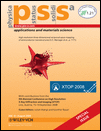Influence of relaxation of the atomic order in f.c.c.-Ni–Al alloys on X-ray diffuse scattering
Abstract
The atomic short-range order (SRO) for the substitutional f.c.c.-Ni–9 at.% Al single-crystal solution is investigated using the X-ray diffuse-scattering method (supplemented by Monte Carlo simulation studies) and analyzing the salient features of the second-order phonon diffuse scattering of X-rays. As shown, in quenched state, the SRO corresponds to the presence in alloy of the static concentration waves with kX(0 0 1) and k(0 0 0.2) wave vectors. Initial SRO-kinetics stage is attended by the noticeable increasing of the diffuse-scattering intensities for wave vectors close to structural (Bragg) reflexes. Parameters of the time dependence of X-ray diffuse-scattering intensity for f.c.c.-Ni–9 at.% Al alloy (after quenching) at low annealing temperature (373 K) are significantly different for different wave vectors generating the ordering and/or clustering processes.




